Related Research Articles
A spear is a pole weapon consisting of a shaft, usually of wood, with a pointed head. The head may be simply the sharpened end of the shaft itself, as is the case with fire hardened spears, or it may be made of a more durable material fastened to the shaft, such as bone, flint, obsidian, iron, steel, or bronze. The most common design for hunting or combat spears since ancient times has incorporated a metal spearhead shaped like a triangle, lozenge, or leaf. The heads of fishing spears usually feature barbs or serrated edges.
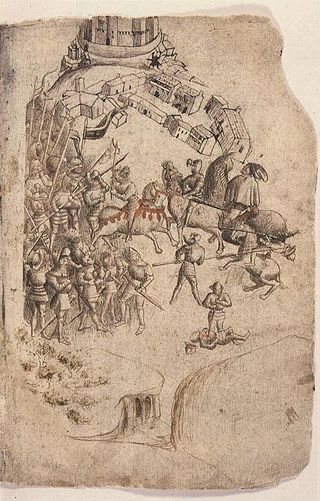
The Battle of Bannockburn was fought on 23–24 June 1314, between the army of Robert the Bruce, King of Scots, and the army of King Edward II of England, during the First War of Scottish Independence. It was a decisive victory for Robert Bruce and formed a major turning point in the war, which ended 14 years later with the de jure restoration of Scottish independence under the Treaty of Edinburgh–Northampton. For this reason, the Battle of Bannockburn is widely considered a landmark moment in Scottish history.

Combined arms is an approach to warfare that seeks to integrate different combat arms of a military to achieve mutually complementary effects—for example, using infantry and armour in an urban environment in which each supports the other.

A pike is a very long thrusting spear formerly used in European warfare from the Late Middle Ages and most of the early modern period, and were wielded by foot soldiers deployed in pike square formation, until it was largely replaced by bayonet-equipped muskets. The pike was particularly well known as the primary weapon of Swiss mercenary and German Landsknecht units. A similar weapon, the sarissa, had been used in antiquity by Alexander the Great's Macedonian phalanx infantry.
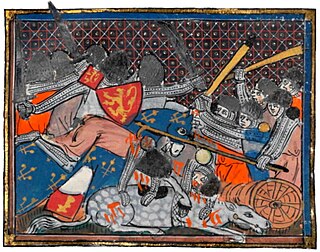
The Battle of the Golden Spurs was a military confrontation between the royal army of France and rebellious forces of the County of Flanders on 11 July 1302 during the Franco-Flemish War (1297–1305). It took place near the town of Kortrijk (Courtrai) in modern-day Belgium and resulted in an unexpected victory for the Flemish. It is sometimes referred to as the Battle of Courtrai.
The Battle of Falkirk, on 22 July 1298, was one of the major battles in the First War of Scottish Independence. Led by King Edward I of England, the English army defeated the Scots, led by William Wallace. Shortly after the battle Wallace resigned as Guardian of Scotland.

The sarisa or sarissa was a long spear or pike about 4 to 6 m in length. It was introduced by Philip II of Macedon and was used in his Macedonian phalanxes as a replacement for the earlier dory, which was considerably shorter. These longer spears improved the strength of the phalanx by extending the rows of overlapping weapons projecting towards the enemy, and the word remained in use throughout the Byzantine years to sometimes describe the long spears of their own infantry.
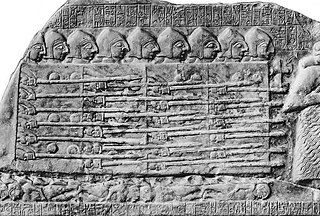
The phalanx was a rectangular mass military formation, usually composed entirely of heavy infantry armed with spears, pikes, sarissas, or similar pole weapons. The term is particularly used to describe the use of this formation in ancient Greek warfare, although the ancient Greek writers used it to also describe any massed infantry formation, regardless of its equipment. Arrian uses the term in his Array against the Alans when he refers to his legions. In Greek texts, the phalanx may be deployed for battle, on the march, or even camped, thus describing the mass of infantry or cavalry that would deploy in line during battle. They marched forward as one entity.

The pike square was a military tactical formation in which 10 rows of men in 10 columns wielding pikes developed by the Swiss Confederacy during the 14th century for use by its infantry.

A shield wall is a military formation that was common in ancient and medieval warfare. There were many slight variations of this formation, but the common factor was soldiers standing shoulder to shoulder and holding their shields so that they would abut or overlap. Each soldier thus benefited from the protection of the shields of his neighbors and his own.
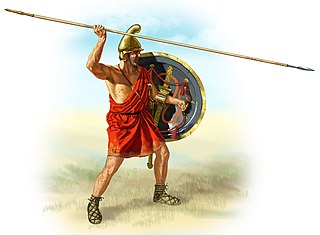
The army of the Kingdom of Macedon was among the greatest military forces of the ancient world. It was created and made formidable by King Philip II of Macedon; previously the army of Macedon had been of little account in the politics of the Greek world, and Macedonia had been regarded as a second-rate power.

A pitched battle or set-piece battle is a battle in which opposing forces each anticipate the setting of the battle, and each chooses to commit to it. Either side may have the option to disengage before the battle starts or shortly thereafter. A pitched battle is not a chance encounter such as a meeting engagement, or where one side is forced to fight at a time not of its choosing such as happens in a siege or an ambush. Pitched battles are usually carefully planned to maximize one's strengths against an opponent's weaknesses and use a full range of deceptions, feints, and other manoeuvres. They are also planned to take advantage of terrain favourable to one's force. Forces strong in cavalry, for example, will not select swamp, forest, or mountain terrain for the planned struggle. For example, Carthaginian General Hannibal selected relatively flat ground near the village of Cannae for his great confrontation with the Romans, not the rocky terrain of the high Apennines. Likewise, Zulu Commander Shaka avoided forested areas or swamps, in favour of rolling grassland, where the encircling horns of the Zulu Impi could manoeuvre to effect. Pitched battles continued to evolve throughout history as armies implemented new technology and tactics.
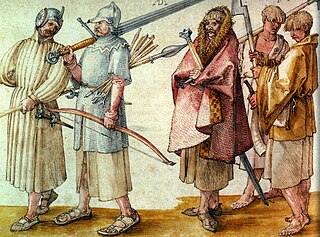
Gaelic warfare was the type of warfare practiced by the Gaelic peoples, in the pre-modern period.

A close order formation is a military tactical formation in which soldiers are close together and regularly arranged for the tactical concentration of force. It was used by heavy infantry in ancient warfare, as the basis for shield wall and phalanx tactics, to multiply their effective weight of arms by their weight of numbers. In the Late Middle Ages, Swiss pikemen and German Landsknechts used close order formations that were similar to ancient phalanxes.

For much of history, humans have used some form of cavalry for war and, as a result, cavalry tactics have evolved over time. Tactically, the main advantages of cavalry over infantry troops were greater mobility, a larger impact, and a higher position.
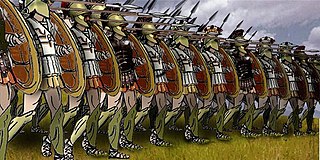
Heavy infantry consisted of heavily armed and armoured infantrymen who were trained to mount frontal assaults and/or anchor the defensive center of a battle line. This differentiated them from light infantry who are relatively mobile and lightly armoured skirmisher troops intended for screening, scouting, and other tactical roles unsuited to soldiers carrying heavier loads. Heavy infantry typically made use of dense battlefield formations, such as shield wall or phalanx, multiplying their effective weight of arms with force concentration.
The Hellenistic armies is the term applied to the armies of the successor kingdoms of the Hellenistic period. The Hellenistic armies emerged after the death of Alexander the Great, when his vast empire was split between his successors, also known as the Diadochi. During the Wars of the Diadochi, the Macedonian army under Philip II and Alexander gradually adopted new units and tactics, further developing Macedonian warfare and improving on the tactics used in the Classical era. The armies of the Diadochi bear few differences from those of Alexander, but during the era of the Epigonoi, the differences were obvious, favoring numbers over quality and weight over maneuverability. The limited availability of Greek conscripts in the east led to an increasing dependence on mercenary forces, whereas in the west, Hellenistic armies were continuously involved in wars, which soon exhausted local manpower, paving the way for Roman supremacy. The major Hellenistic states were the Seleucid Empire, Ptolemaic Egypt and Macedonia during the Antigonid kingdom. Smaller states included Attalid Pergamum, Pontus, Epirus, the Achaean League, the Aetolian League, Syracuse, and other nations such as Athens, Sparta, etc.

Despite the rise of knightly cavalry in the 11th century, infantry played an important role throughout the Middle Ages on both the battlefield and in sieges. From the 14th century onwards, there was a rise in the prominence of infantry forces, sometimes referred to as an "infantry revolution".
The phoulkon, in Latin fulcum, was an infantry formation utilized by the military of the late Roman and Byzantine Empire. It is a formation in which an infantry formation closes ranks and the first two or three lines form a shield wall while those behind them hurl projectiles. It was used in both offensive and defensive stances.

The Macedonian phalanx was an infantry formation developed by Philip II from the classical Greek phalanx, of which the main innovation was the use of the sarissa, a 6-metre pike. It was famously commanded by Philip's son Alexander the Great during his conquest of the Achaemenid Empire between 334 and 323 BC. The Macedonian phalanx model then spread throughout the Hellenistic world, where it became the standard battle formation for pitched battles. During the Macedonian Wars against the Roman Republic, the phalanx appeared obsolete against the more manoeuvrable Roman legions.
References
- ↑ scildtruma,sceldtroman,scheltron Bosworth, Joseph; T. Northcote Toller. An Anglo-Saxon dictionary. p. 831.
- ↑ see examples in the Electronic English Dictionary
- ↑ Fisher, Andrew (1986). William Wallace. Edinburgh: John Donald. p. 80. ISBN 0-85976-154-1.
- ↑ Aitchison, Nick (2003). The Picts and Scots at War. Stroud: Sutton. p. 88. ISBN 0-7509-2556-6.
- ↑ Linklater, Eric (1968). The Survival of Scotland . Garden City, NY: Doubleday.
- ↑ Fisher (1986), op.cit., p. 80
- ↑ Oman, Charles (1924). The Art of War in the Middle Ages. Vol. 2. London: Greenhill. p. 80. ISBN 1-85367-100-2.
- ↑ Spencer-Churchill, Winston L. A History of the English-Speaking Peoples, Volume 1, The Birth of Britain (New York: Bantam Books, 1974, 12h printing), p. 225.
- ↑ Vita Edwardi Secundi, quoted in Brown, Chris (2008). Bannockburn 1314. Stroud: History press. p. 78. ISBN 978-0-7524-4600-4.
- ↑ Trokelowe, quoted in Brown, op.cit, p. 90
- ↑ Brown, op.cit., p. 132
- ↑ DeVries, Kelly (1996). Infantry Warfare in the Early Fourteenth Century. Woodbridge: Boydell Press. p. 94. ISBN 0-85115-567-7.
- ↑ Rogers, Clifford (2007). Soldiers' Lives Through History : The Middle Ages. Westport, CT: Greenwood Press. p. 162. ISBN 978-0-313-33350-7.
- ↑ Oman, op.cit, pp. 69–71
- ↑ Verbruggen, J.F. (1997). The Art of Warfare in Western Europe during the Middle Ages (2nd. ed.). Woodbridge: Boydell Press. pp. 190–4. ISBN 0-85115-630-4.
- ↑ Verbruggen, op.cit, p. 184